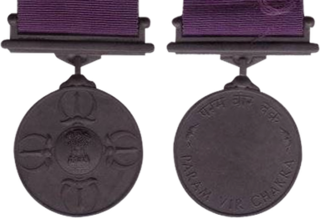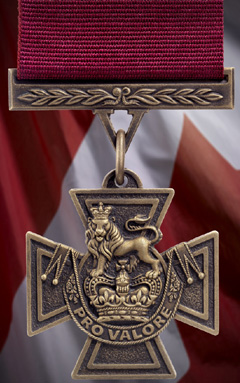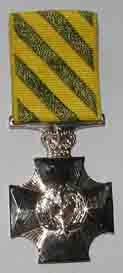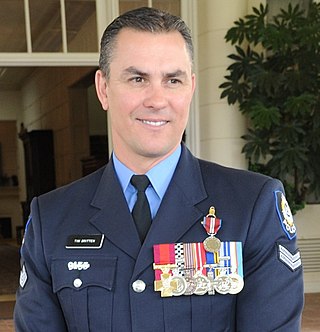The George Cross (GC) is the highest award bestowed by the British government for non-operational gallantry or gallantry not in the presence of an enemy. In the British honours system, the George Cross, since its introduction in 1940, has been equal in stature to the Victoria Cross, the highest military gallantry award. It is awarded "for acts of the greatest heroism or for most conspicuous courage in circumstance of extreme danger", not in the presence of the enemy, to members of the British armed forces and to British civilians. Posthumous awards have been allowed since it was instituted. It was previously awarded to residents of Commonwealth countries, most of which have since established their own honours systems and no longer recommend British honours. It may be awarded to a person of any military rank in any service and to civilians including police, emergency services and merchant seamen. Many of the awards have been personally presented by the British monarch to recipients or, in the case of posthumous awards, to next of kin. The investitures are usually held at Buckingham Palace.
The Australian honours and awards system refers to all orders, decorations, and medals, as instituted by letters patent from the Monarch of Australia and countersigned by the Australian prime minister at the time, that have been progressively introduced since 14 February 1975. The Australian honours and awards system excludes all state and local government, and private, issued awards and medals.

The Param Vir Chakra (PVC) is India's highest military decoration, awarded for displaying distinguished acts of valour during wartime. Param Vir Chakra translates as the "Wheel of the Ultimate Brave", and the award is granted for "most conspicuous bravery in the presence of the enemy". As of January 2018, the medal has been awarded 21 times, of which 14 were posthumous and 16 arose from actions in Indo-Pakistani conflicts. Of the 21 awardees, 20 have been from the Indian Army and one has been from the Indian Air Force. Major Somnath Sharma was the first recipient. A number of state governments of India as well as ministries of the central government provide allowances and rewards to recipients of the PVC.
The orders, decorations, and medals of Canada comprise a complex system by which Canadians are honoured by the country's sovereign for actions or deeds that benefit their community or the country at large. Modelled on its British predecessor, the structure originated in the 1930s, but began to come to full fruition at the time of Canada's centennial in 1967, with the establishment of the Order of Canada, and has since grown in both size and scope to include dynastic and national orders, state, civil, and military decorations; and various campaign medals. The monarch in right of each Canadian province also issues distinct orders and medals to honour residents for work performed in just their province. The provincial honours, as with some of their national counterparts, grant the use of post-nominal letters and or supporters and other devices to be used on personal coats of arms.

The Victoria Cross was created in 1993, perpetuating the lineage of the British Victoria Cross, while serving as the highest award within the Canadian honours system, taking precedence over all other orders, decorations, and medals. It is awarded by either the Canadian monarch or his viceregal representative, the governor general of Canada, to any member of the Canadian Armed Forces or allies serving under or with Canadian military command for extraordinary valour and devotion to duty while facing hostile forces. The British Victoria Cross was recommended prior to the creation of the Canadian medal. The previous Victoria Cross remains the highest award of the United Kingdom honours system and was also awarded in other Commonwealth countries; although most, including Canada, later established their own honours systems and no longer recommended British honours.

The Conspicuous Service Cross (CSC) is a decoration (medal) of the Australian honours system. It is awarded to members of the Australian Defence Force "for outstanding devotion to duty or outstanding achievement in the application of exceptional skills, judgment or dedication, in non-warlike situations". In November 2019, 1129 people were listed as recipients. All ranks are eligible for the award.
The Distinguished Service Cross (DSC) is a military decoration awarded to personnel of the Australian Defence Force. It is awarded for distinguished command and leadership in action. The DSC was introduced in 1991 and is the highest distinguished service decoration in the Australian Honours System. Recipients of the Distinguished Service Cross are entitled to use the post-nominal letters "DSC". Since its inception 115 awards have been made—which includes eight first bars and one second bar.
The Distinguished Service Medal (DSM) is a military decoration awarded to personnel of the Australian Defence Force for distinguished leadership in warlike operations. The DSM was introduced in 1991 and is the second highest distinguished service decoration in the Australian Honours System. Recipients of the Distinguished Service Medal are entitled to use the post-nominal letters "DSM". Since its inception 152 awards have been made—which includes six Bars—with the most recent being announced in the 2021 Queen's Birthday Honours.
The Star of Gallantry (SG) is a military decoration awarded to personnel of the Australian Defence Force (ADF) and other persons recognised by the Minister for Defence. It is awarded for acts of great heroism or conspicuous gallantry in action in circumstances of great peril. It is the second highest of the military gallantry awards in the Australian Honours System, only surpassed by the Victoria Cross or Victoria Cross for Australia (VC).
The Medal for Gallantry(MG) is a military decoration awarded to personnel of the Australian Defence Force. It recognises acts of gallantry in action in hazardous circumstances. The MG was introduced on 15 January 1991, replacing the Imperial equivalent. It is ranked third in the Gallantry Decorations in the Australian Honours System. Recipients of the Medal of Gallantry are entitled to use the post-nominal letters "MG".
The Star of Courage (SC) is a bravery decoration awarded to Australians. It is awarded for acts of conspicuous courage in circumstances of great peril. The SC was created on 14 February 1975. The decoration recognises acts of bravery by members of the community. They selflessly put themselves in jeopardy to protect the lives or property of others. It is ranked second in the Australian civil bravery decorations in the Australian Honours System. Recipients of the Star of Courage are entitled to use the post-nominal letters "SC".
The Victoria Cross for Australia is the highest award in the Australian honours system, superseding the British Victoria Cross for issue to Australians. The Victoria Cross for Australia is the "decoration for according recognition to persons who in the presence of the enemy, perform acts of the most conspicuous gallantry, or daring or pre-eminent acts of valour or self-sacrifice or display extreme devotion to duty."

The Cross of Valour is a decoration that is, within the Canadian system of honours, the second-highest award, the highest honour available for Canadian civilians, and the highest of the three Canadian Bravery Decorations. Created in 1972, it is presented to individuals, both Canadian and foreign, living and deceased, who have performed acts of the most conspicuous courage in circumstances of extreme peril. Recipients are allowed to use the post-nominal letters CV.

The Victoria Cross (VC) is the highest and most prestigious decoration of the British honours system. It is awarded for valour "in the presence of the enemy" to members of the British Armed Forces and may be awarded posthumously. It was previously awarded by countries of the Commonwealth of Nations, most of which have established their own honours systems and no longer recommend British honours. It may be awarded to a person of any military rank in any service and to civilians under military command. No civilian has received the award since 1879. Since the first awards were presented by Queen Victoria in 1857, two thirds of all awards have been personally presented by the British monarch. The investitures are usually held at Buckingham Palace.

Timothy Ian Britten is a senior sergeant in the Western Australia Police. He is one of the five recipients of the Cross of Valour, Australia's highest civilian bravery decoration. He was awarded the Cross of Valour for his actions in the immediate aftermath of the 2002 Bali bombings.
The Special Honours Lists for Australia are announced by the Sovereign and Governor-General at any time.
The Special Honours Lists for Australia are announced by the Sovereign and Governor-General at any time.







